Canals in Britain
Tony Conder
เม.ย. 2017 · Bloomsbury Publishing
eBook
80
หน้า
reportคะแนนและรีวิวไม่ได้รับการตรวจสอบยืนยัน ดูข้อมูลเพิ่มเติม
เกี่ยวกับ eBook เล่มนี้
In the early years of the Industrial Revolution, canals formed the arteries of Britain. Most waterways were local concerns, carrying cargoes over short distances and fitted into regional groups with their own boat types linked to the major river estuaries. This new history of Britain's canals starts with the first Roman waterways, moving on to their golden age in the eighteenth and early nineteenth centuries, and ends with the present day, describing the rise and fall of canal building and use in the UK. It tells the story of the narrow boats and barges borne by the canals, and the boatmen who navigated them as well as the wider tale of waterway development through the progress of civil engineering. Replete with beautiful photographs, this a complete guide to some of the most accessible and beautiful pieces of Britain's heritage.
เกี่ยวกับผู้แต่ง
Tony Conder has been involved with inland waterways since his parents first took him for walks beside the Wey Navigation. For twenty-five years he was Curator of the British Waterways Collection. Initially he was based at Stoke Bruerne, from where he collected objects from all over the canal system. In 1988 he opened the National Waterways Museum at Gloucester and in 1999 became Curator to the Waterways Trust, taking the collection to national designated status.
ให้คะแนน eBook นี้
แสดงความเห็นของคุณให้เรารับรู้
ข้อมูลในการอ่าน
สมาร์ทโฟนและแท็บเล็ต
ติดตั้งแอป Google Play Books สำหรับ Android และ iPad/iPhone แอปจะซิงค์โดยอัตโนมัติกับบัญชีของคุณ และช่วยให้คุณอ่านแบบออนไลน์หรือออฟไลน์ได้ทุกที่
แล็ปท็อปและคอมพิวเตอร์
คุณฟังหนังสือเสียงที่ซื้อจาก Google Play โดยใช้เว็บเบราว์เซอร์ในคอมพิวเตอร์ได้
eReader และอุปกรณ์อื่นๆ
หากต้องการอ่านบนอุปกรณ์ e-ink เช่น Kobo eReader คุณจะต้องดาวน์โหลดและโอนไฟล์ไปยังอุปกรณ์ของคุณ โปรดทำตามวิธีการอย่างละเอียดในศูนย์ช่วยเหลือเพื่อโอนไฟล์ไปยัง eReader ที่รองรับ





